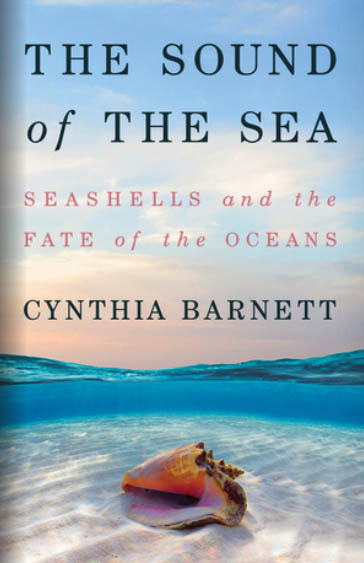Cynthia Barnett, The Sound of the Sea: Seashells and the Fate of the Oceans (W.W. Norton, 2021)
 Rachel Carson would have loved The Sound of the Sea. With it, Cynthia Barnett has arrived, borne upon a Botticelli shell, as a true heir to Carson’s legacy. The luminous prose in Carson’s first book, Under the Sea-Wind, carries readers along the Atlantic seacoast with birds and bivalves, on epic avian migrations to the Artic tundra, to the lives beneath the waves of marine creatures — mackerel and mullets, cephalopods and sharks, eels and octopuses. It was researched and written before there was Technicolor, Jacques Cousteau, the aqualung, or underwater film. Similar wonder, imagination, awe, and empathy for strange living creatures suffuses Barnett’s beautifully wrought homage to mollusks. Their lives — cowries, conchs, clams, moons, whelks, scallops — have created the beautiful shells and curio shop stuff that have fascinated humans and influenced human society since prehistoric times.
Rachel Carson would have loved The Sound of the Sea. With it, Cynthia Barnett has arrived, borne upon a Botticelli shell, as a true heir to Carson’s legacy. The luminous prose in Carson’s first book, Under the Sea-Wind, carries readers along the Atlantic seacoast with birds and bivalves, on epic avian migrations to the Artic tundra, to the lives beneath the waves of marine creatures — mackerel and mullets, cephalopods and sharks, eels and octopuses. It was researched and written before there was Technicolor, Jacques Cousteau, the aqualung, or underwater film. Similar wonder, imagination, awe, and empathy for strange living creatures suffuses Barnett’s beautifully wrought homage to mollusks. Their lives — cowries, conchs, clams, moons, whelks, scallops — have created the beautiful shells and curio shop stuff that have fascinated humans and influenced human society since prehistoric times.
Seen as a whole, Rachel Carson’s work combines the wondrous prose and empathy so vividly on display in Under the Sea-Wind, with a deep, scientific exploration of the sea and its origins, the evolution of all life and the creatures we collect or admire, along with the disastrous effects on our planet and our lives that human hubris has produced. Her intertwined narrative first introduced the broad American public to ecology and its connection to human health. Carson is able, finally, in Silent Spring, to move and outrage us even at the death of a single backyard robin.
Cynthia Barnett has done the same for the seashell.
Carson was hobbled by health problems, burdened as a single woman by providing and caring for her entire extended family, and unable to travel widely. She mainly bird watched, plumbed tidal pools, combed Atlantic beaches. The rest of her magic came from relentless research, wide reading, frequent correspondence with experts, and that miraculous ability to make her readers see and, most of all, to feel.
Barnett has done that, too.
Carson begins Silent Spring with “A Fable,” a fictional, but factually possible, story of a beautiful, but deserted town where no birds sing. Barnett opens with a girl walking a rocky beach along the Mediterranean looking for cockle shells with holes in the top so she can make a necklace. The girl is a Neanderthal from 100,000 years ago.
Thus, The Sound of the Sea begins with modern science, but recreated as a story using the latest understanding that Neanderthals were artistic and creative, not brutes, as evidenced, among other things, by painted shell cases they fashioned to hold cosmetics made from colorful ground minerals.
With Barnett’s narrative, we follow the shells and human culture forward from prehistory through the pre-Columbian, colonial, and modern eras. As we journey forward, humans slowly move from seeing mollusks and their shells as central to creation myths, as life-giving organisms who filter the oceans, provide food, decorate shrines, and as subjects of careful, loving, outdoor observation recommended for youth by the nature study movement that influenced Rachel Carson and others.
Barnett notes that by the 1950s, Carson was already warning of the growing scarcity of Queen Conchs in the Florida Keys even as these “sentient beings” were being sold at roadside stands. Shells have become in our time commercial products that are relentlessly pursued, gathered, and sold at industrial scale, even as they are endangered or driven to extinction. And even when their breeding grounds have been made marine preserves with harvesting banned and pollution abated, they are suffering from the warming waters of global climate change.
 Like Carson, Cynthia Barnett is not given to scolding or gloom and doom. She offers hope as she observes a growing awareness worldwide of the need to study, preserve and learn from these living animals who have survived mankind’s manipulation of the environment. Thanks to Barnett we are able to meet and hear and see the people who love and learn from mollusks. Imagine if Rachel Carson, too, had been able to travel to Ghana or Palau, to snorkel and scuba dive throughout the world’s oceans and lagoons, to explore with archeologists and biologists in Peru, or to visit labs, aquariums, natural history museums, and science centers throughout the U.S. and Europe. The result would have been something like The Sound of the Sea.
Like Carson, Cynthia Barnett is not given to scolding or gloom and doom. She offers hope as she observes a growing awareness worldwide of the need to study, preserve and learn from these living animals who have survived mankind’s manipulation of the environment. Thanks to Barnett we are able to meet and hear and see the people who love and learn from mollusks. Imagine if Rachel Carson, too, had been able to travel to Ghana or Palau, to snorkel and scuba dive throughout the world’s oceans and lagoons, to explore with archeologists and biologists in Peru, or to visit labs, aquariums, natural history museums, and science centers throughout the U.S. and Europe. The result would have been something like The Sound of the Sea.
This is a book crying out to be read by every American and, on campuses, to be assigned to all incoming first-year students, to introduce undergraduates in many courses to marine science, natural history, biology, archeology, anthropology, globalization and economics, and plain old great writing, science writing and journalism at its finest. It’s hard to rank with Rachel Carson, but with The Sound of the Sea, Cynthia Barnett surely does.
— Bob Musil
 Dr. Robert K. Musil is President & CEO of the Rachel Carson Council and co-leads the RCC’s Coasts and Ocean Program. He is the author of Rachel Carson and Her Sisters: Extraordinary Women Who Have Shaped America’s Environment and a forthcoming annotated and illustrated edition, with his Introduction and a Prologue by Deborah Cramer, of Rachel Carson’s Under the Sea-Wind (Rutgers University Press).
Dr. Robert K. Musil is President & CEO of the Rachel Carson Council and co-leads the RCC’s Coasts and Ocean Program. He is the author of Rachel Carson and Her Sisters: Extraordinary Women Who Have Shaped America’s Environment and a forthcoming annotated and illustrated edition, with his Introduction and a Prologue by Deborah Cramer, of Rachel Carson’s Under the Sea-Wind (Rutgers University Press).






